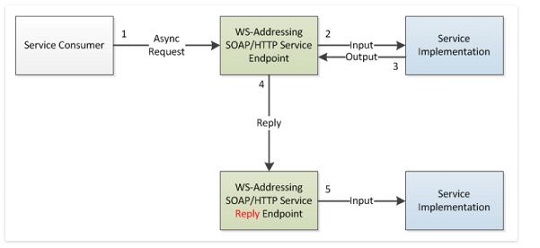Loading...
ActiveMatrix ServiceGrid
Corporate
Online
TIBCO
TIBCOServiceGrid
Training
WS-Addressing
WS-Addressing in ActiveMatrix ServiceGrid
https://tibcoservicegridonlinetraining.blogspot.com/2015/08/ws-addressing-in-servicegrid.html
WS-Addressing
basics
The basics are that WS-Addressing
defines standardized SOAP headers that identify how a service consumer can
indicate the endpoint to which the service should send its response (and/or
send SOAP faults) – in a request/response invocation of course. The client
sends a SOAP request to the service and the service communications, AMSG in
this case, knows that it should treat the request in an asynchronous manner (so
the client doesn’t wait for the response). The service implementation generates
a response and returns this to the AMSG service component, which interprets the
WS-Addressing headers and then automatically forwards the reaction SOAP
envelope to the URI mentioned in the Reply To header.
When
is WS-Addressing useful?
I wondered for a moment why this would
be useful. I mean, it would be trivial to write a service with an in-only MEP
and code the service so that it invokes another service (the “reply service”)
as the last thing it does. The service would still have an asynchronous nature,
and would still appeal to another service on completion. Perhaps the answer is
already clear to you, but it took me a few moments of thought to work out.
The power of WS-Addressing is that the
service consumer is able to specify to which endpoint the reply should be sent.
It’s not hardcoded in the service implementation – it’s specified by the
consumer. This, obviously, makes the solution more supple in that each consumer
could specify a different reply URI/service, but at the same time WS-Addressing
adds a convinced amount of complexity in that it’s not always obvious to one
that replies aren’t sent to the consumer.
An important point to mention is that in
the case of WS-Addressing it should be clear that the “reply service” shouldn’t
be seen as a part of the consumer – and not as an addition of the service.
Outline
To summarized, the difference between
WS-Addressing and hard-coding the reply service in the service implementation
is:
..WS-Addressing is more stretchy than
hard-coding the reply location in that it allows the consumer to specify the
reply endpoint.
..WS-Addressing reply endpoints are a
part of (and thus under the governance of) the consumer, not a part of the
target service.
ActiveMatrix ServiceGrid,
Corporate,
Online,
TIBCO,
TIBCOServiceGrid,
Training,
WS-Addressing,
WS-Addressing in ActiveMatrix ServiceGrid
WS-Addressing in ActiveMatrix ServiceGrid
7729292746846653105
Post a Comment
Home
item
Blog Archive
Popular Posts
-
Service Component Architecture (SCA) defines a model for developing applications based on a service-oriented architecture. Business job ...
-
TIBCO ActiveMatrix applications presume different forms in different phases of the application life cycle. In the design phase a TIB...
-
WS-Addressing basics The basics are that WS-Addressing defines standardized SOAP headers that identify how a service consumer can ind...
-
ActiveMatrix Service Grid provides a unified design-time and runtime service structure based on the SCA/OSGI specification. Thi...
-
TIBCO ActiveMatrix Service Grid is a complete SOA development platform that lets you change business logic written in dissimilar progr...




